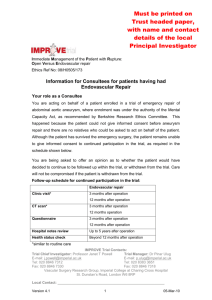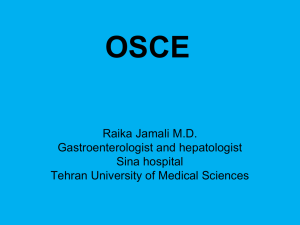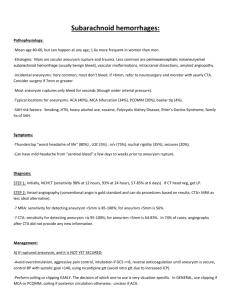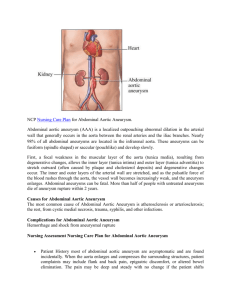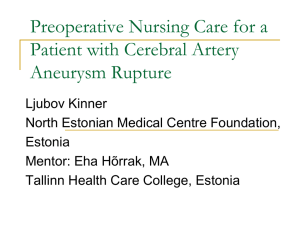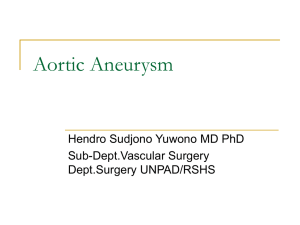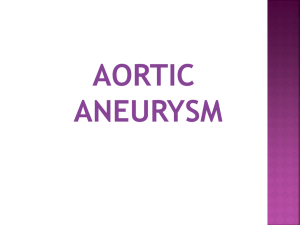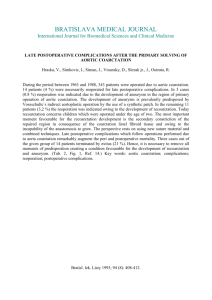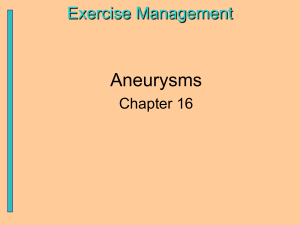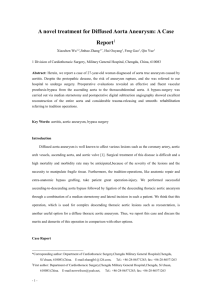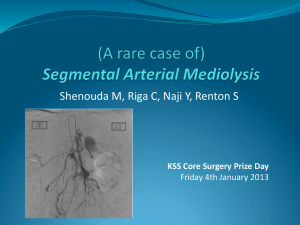Post-operative Patient Information after Endovascular Repair
advertisement
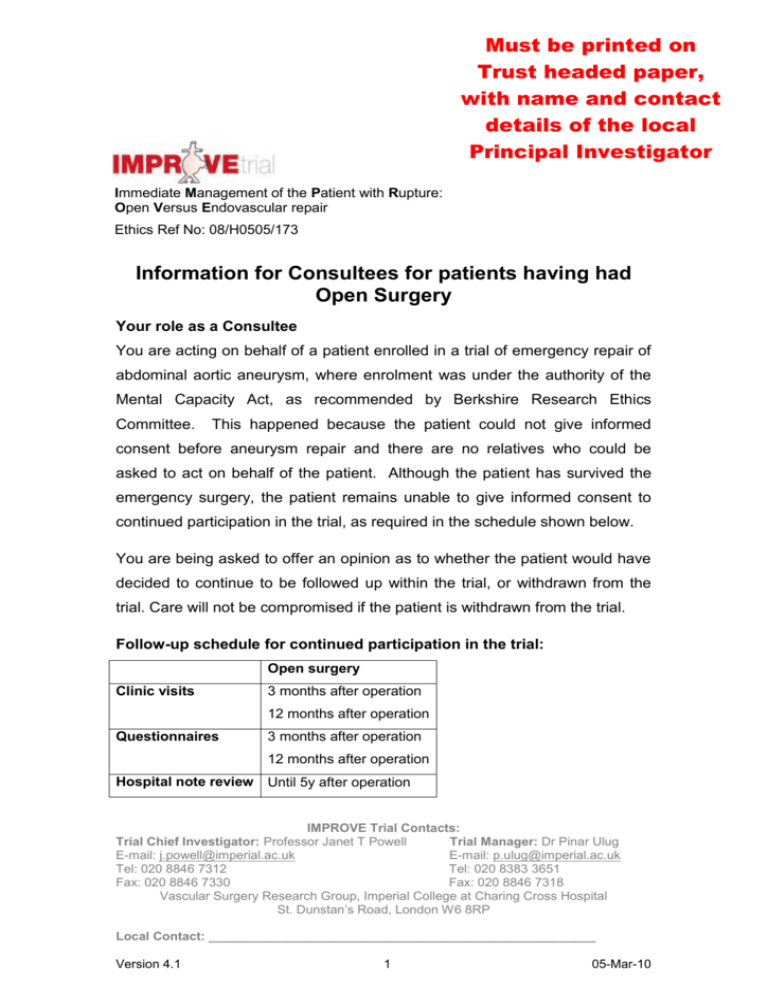
Must be printed on Trust headed paper, with name and contact details of the local Principal Investigator Immediate Management of the Patient with Rupture: Open Versus Endovascular repair Ethics Ref No: 08/H0505/173 Information for Consultees for patients having had Open Surgery Your role as a Consultee You are acting on behalf of a patient enrolled in a trial of emergency repair of abdominal aortic aneurysm, where enrolment was under the authority of the Mental Capacity Act, as recommended by Berkshire Research Ethics Committee. This happened because the patient could not give informed consent before aneurysm repair and there are no relatives who could be asked to act on behalf of the patient. Although the patient has survived the emergency surgery, the patient remains unable to give informed consent to continued participation in the trial, as required in the schedule shown below. You are being asked to offer an opinion as to whether the patient would have decided to continue to be followed up within the trial, or withdrawn from the trial. Care will not be compromised if the patient is withdrawn from the trial. Follow-up schedule for continued participation in the trial: Open surgery Clinic visits 3 months after operation 12 months after operation Questionnaires 3 months after operation 12 months after operation Hospital note review Until 5y after operation IMPROVE Trial Contacts: Trial Chief Investigator: Professor Janet T Powell Trial Manager: Dr Pinar Ulug E-mail: j.powell@imperial.ac.uk E-mail: p.ulug@imperial.ac.uk Tel: 020 8846 7312 Tel: 020 8383 3651 Fax: 020 8846 7330 Fax: 020 8846 7318 Vascular Surgery Research Group, Imperial College at Charing Cross Hospital St. Dunstan’s Road, London W6 8RP Local Contact: ______________________________________________________ Version 4.1 1 05-Mar-10 The patient is under no obligation to continue in the study and may withdraw any time without giving a reason. If the patient withdraws from the study, care will not be compromised and they will be offered standard follow-up. After open repair this usually comprises one or two clinic visits post-operatively. If the patient remains in the trial they will be asked to attend two clinic appointments in the first post-operative year (see schedule). We also seek permission to review the patient’s hospital notes for up to 5 years after the operation. Summary of the IMPROVE trial This patient had a ruptured abdominal aortic aneurysm. This is a condition where the main blood vessel in the tummy has swollen over many years and burst causing extensive bleeding. Many patients with this condition do not survive to reach hospital alive. Of those that reach hospital alive only 50% will survive the operation to repair the aorta and stop the bleeding. Until recently there was only one way to repair the ruptured aneurysm. This involved major surgery with a large cut in the tummy and replacement of the diseased aorta with a plastic (Polyester) tube (open surgery) and only half the patients leave hospital alive. Recent technical advances have made it possible to re-line the ruptured aorta using a stent introduced through two small cuts in the groin (endovascular repair) and it is possible that a greater proportion of patients will leave hospital alive. However, at present we do not know which of the treatments is best for people with ruptured aneurysm. This patient has been enrolled in a trial involving a number of specialist UK hospitals. The trial compares the two techniques for repair of ruptured abdominal aortic aneurysm in many patients. When this patient was admitted to hospital we did not know whether they would receive endovascular or open repair. The patient had an open repair, and we shall advise the GP of this when the patient leaves hospital. Version 4.1 2 05-Mar-10 What is an AAA? An aneurysm is a localised, balloon-like stretching of a weakened artery (blood vessel) wall. Although this can happen to any artery in the body, the most commonly affected vessel is the aorta which is the main central artery in the body. It carries blood from the heart down through the chest and abdomen (stomach) and branches out to all of the body’s major organs. A normal aorta is about 1.5-2.5cm (¾ -1 inch) in diameter. This diagram shows what your aorta looks like with an aneurysm Aortic aneurysms are often silent with no obvious symptoms. However, about 1 in 4 patients will experience some symptoms such as tenderness in the chest or stomach area, back pain and/or reduced blood flow to their legs. When an abdominal aortic aneurysm increases in size, and particularly when the diameter is 5.5cm (2 ¼ inches) or greater, there is an increasing risk that the artery wall will leak or even burst. This is known as a “rupture” and leads to dangerous bleeding inside the body. Ruptured abdominal aortic aneurysm A ruptured aneurysm can be associated with severe pain in the stomach or back area, a rapid heart beat, a pulsing sensation in the stomach and skin feeling “cold and sweaty”. Only 2 in 10 people survive an aortic aneurysm rupture and just half of all patients manage to get to a hospital at all. About 12,000 people die from ruptured aneurysms in U.K. every year. Version 4.1 3 05-Mar-10 What causes an abdominal aortic aneurysm? Aortic aneurysm can occur when the wall of the aorta has been damaged and weakened by one or more of the possible risk factors such as: • Smoking • High blood pressure • Atherosclerosis - build up of fatty deposits leading to deterioration of the artery wall and loss of elasticity • Inherited aortic wall weakness / family history • Age Infection and injury are also thought to be possible causes for the artery to expand and form an aneurysm. Who gets an abdominal aortic aneurysm? Aneurysms occur in approximately 1 in 20 men over the age of 65. They are four to five times more common in men than women. There is also an increased risk of a younger man developing an aneurysm if his father, mother or brother has been diagnosed with the condition. What is open surgical repair of an abdominal aortic aneurysm? This method of aortic aneurysm repair was developed in the mid-1950s. It is a major operation carried out by Vascular Surgeons in an operating theatre and the patient is given a general anaesthetic. A large cut, starting from just below the chest, is usually made lengthways to the abdomen to expose the aorta and clamps are temporarily placed above and below the aneurysm to shut off the blood flow through the vessel and stop the bleeding. Blood flow to the legs is interrupted while the aorta is clamped. This is not usually a problem as heparin is given to prevent the blood from clotting. The aneurysm is cut open and any blood clot or debris is removed from within it. The artificial graft is then sewn onto the blood vessel at the top and bottom of the aneurysm sac where there is no disease, so that it lies within what was the inside of the aneurysm. When the clamps have been removed and blood flow is reestablished without any leaks, the wall of the aneurysm is closed over the graft to protect it. Patients will require a blood transfusion during or after the operation to replace several litres which is typically lost during the procedure Version 4.1 4 05-Mar-10 although this amount may be much greater in difficult or prolonged operations. The surgery usually takes 2 – 3 hours to complete. This diagram shows an artificial graft being sewn into the artery inside the aneurysm. Hospital stay, recovery time and follow-up: Most patients will spend several days or longer after an open repair in an Intensive Care Unit (ICU). They will remain in hospital for a total of 7-10 days or more. Full recovery from a major operation of this type can typically take up to 3-6 months. Long term complications after a successful repair are comparatively rare. The grafts are known to last for 20-30 years and so patients do not need further follow-up appointments beyond three months after a successful repair. What are the risks and complications associated with open surgical repair? Ruptured aortic aneurysm is an immediately life threatening procedure. Without an operation patients do not survive. Consequently operations to save patients lives are associated with major complications, which include heart attack, stroke, kidney failure, chest and wound problems. Will the patient’s part in this study be kept confidential? Some parts of the patient’s medical records and the data collected for the study will be looked at by authorised persons from the team organising the research. They may also be looked at by representatives of regulatory authorities and by authorised people to check that the study is being carried Version 4.1 5 05-Mar-10 out correctly. The NHS Information Centre and NHS Central Register may use this information to help contact the patient and provide information about the patient’s health status. All will have a duty of confidentiality to the patient as a research participant and we will do our best to meet this duty. Who has reviewed this study (the IMPROVE trial)? The Health Technology Assessment programme of the National Institute for Health Research is supporting this study. The study has received a favourable ethical opinion for conduct by the Berkshire Research Ethics Committee and the Scotland A Research Ethics Committee. What if something goes wrong? Imperial College London (the trial Sponsor) holds insurance policies which apply to this study. If you experience harm or injury as a result of taking part in this study, you will be eligible to claim compensation without having to prove that Imperial College is at fault. This does not affect your legal rights to seek compensation. If you are harmed due to someone's negligence, then you may have grounds for a legal action. Regardless of this, if you wish to complain, or have any concerns about any aspect of the way you have been treated during the course of this study then you should immediately inform the Chief Investigator (Professor Janet T. Powell) and local Principal Investigator, whose contact details have been provided on page 1. The normal National Health Service complaints mechanisms are also available to you. If you are still not satisfied with the response, you may contact the Imperial College Joint Research Office . Further information If you have any questions about the study, please speak to the study nurse or doctor, who will be able to provide you with up to date information about the procedures involved If you would like to read more about this trial you can contact: Version 4.1 6 05-Mar-10 Name: Telephone: Email: Study website: www.improvetrial.org www.clinicaltrials.gov Trial ID:NTC00746122 Version 4.1 7 05-Mar-10
